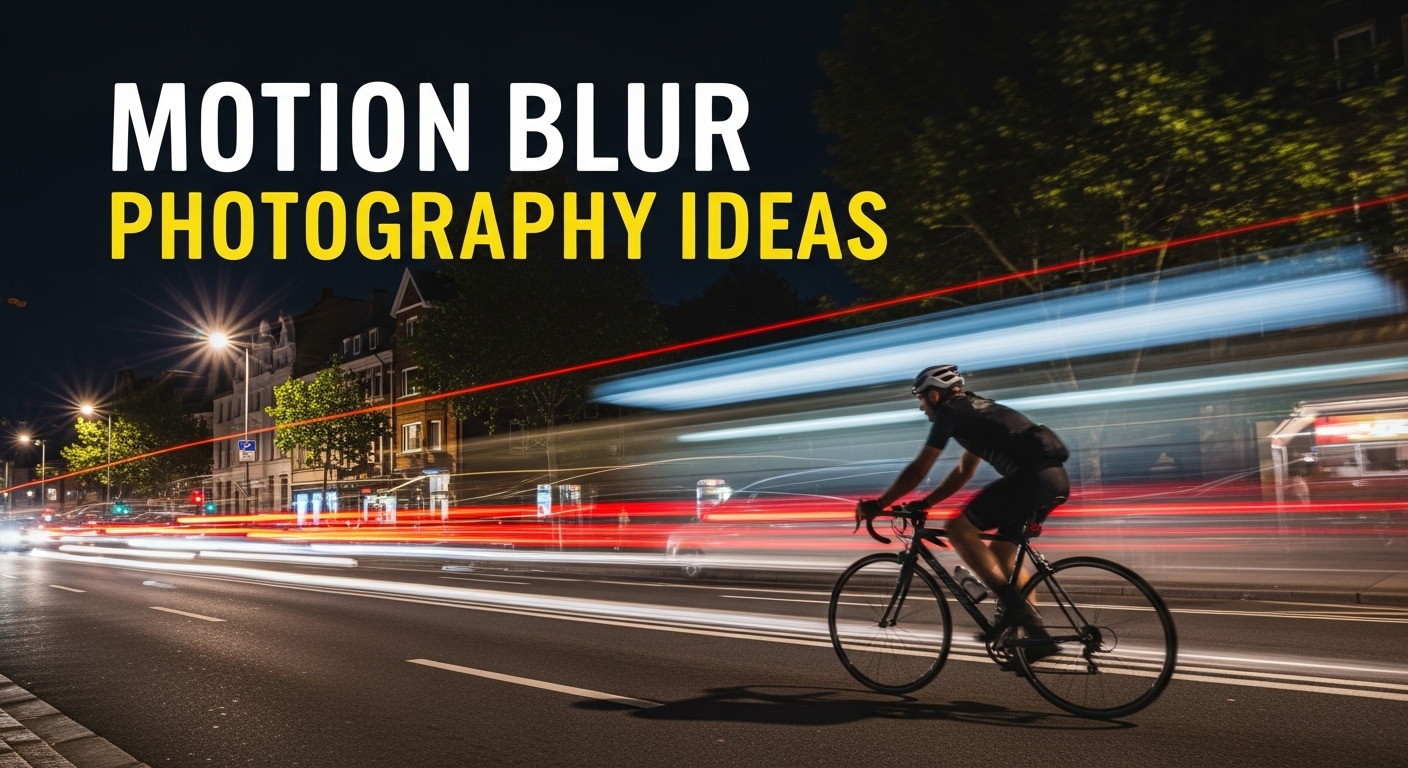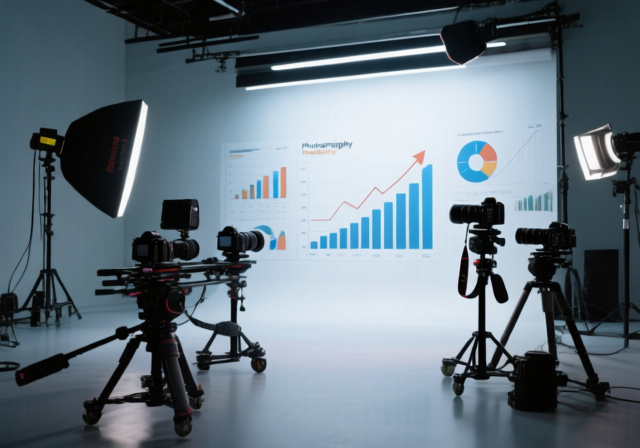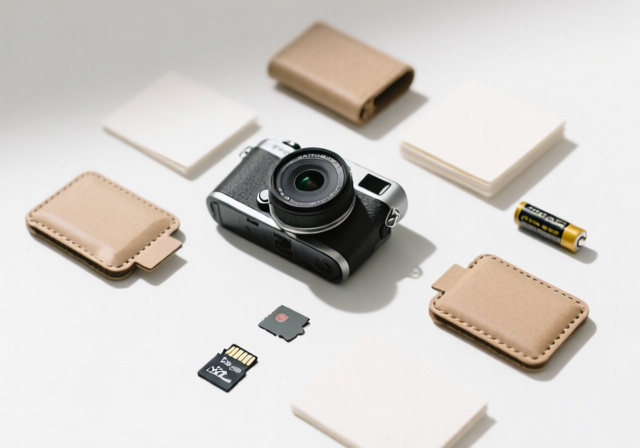

Ever wondered how photographers transform ordinary scenes into dynamic works of art that seem to dance with movement? Motion blur photography is the answer – it’s the technique that turns running water into silky ribbons, city lights into flowing rivers of color, and moving subjects into streaks of energy.
Motion blur photography ideas encompass any creative technique that intentionally uses movement to create artistic effects in your images. By controlling your camera’s shutter speed, you can freeze time or let it flow, capturing not just what a scene looks like, but what it feels like.
After spending 15 years experimenting with these techniques across countless locations and lighting conditions, I’ve discovered that motion blur isn’t just about technical settings – it’s about learning to see the world differently and capturing the energy that surrounds us every day.
In this comprehensive guide, you’ll learn everything from basic camera settings to advanced creative techniques, plus 25 practical ideas you can try immediately, regardless of your equipment or skill level.
Motion blur is a photographic technique where moving subjects appear blurred while stationary elements remain sharp, created by using slower shutter speeds to capture movement over time.
Unlike accidental blur from camera shake, intentional motion blur is a creative choice that adds energy, emotion, and storytelling to your images. It works by keeping the camera’s shutter open longer, allowing the sensor to record light from moving subjects as streaks or trails, creating a visual representation of movement.
The beauty of motion blur lies in its ability to show not just where something was, but how it got there. This creates a sense of time passing and can transform static scenes into dynamic narratives that engage viewers on an emotional level.
For more photography techniques and guides, explore our comprehensive collection of tutorials covering all skill levels.
While you can create motion blur with any camera, having the right equipment makes the process easier and more predictable. The good news? You don’t need to break the bank to get started.
✅ Budget-Friendly Starting Point: Start with what you have – even a smartphone can create motion blur effects. Focus on technique first, then gradually add equipment as you identify specific needs.
A sturdy tripod is essential for most motion blur techniques, preventing unwanted camera shake while allowing intentional movement. You don’t need the most expensive model – something stable that can hold your camera steady is perfect.
For long exposure work like silky water effects or light trails, a tripod is non-negotiable. I learned this the hard way when my cheap tripod collapsed during a golden hour shoot, ruining what could have been my best waterfall image to date.
Budget alternatives include using stable surfaces like rocks, railings, or even bean bags. In urban environments, I’ve used park benches, window ledges, and even the ground to get steady shots when traveling light.
ND filters are like sunglasses for your camera – they reduce light entering the lens without affecting color, allowing slower shutter speeds even in bright conditions. This is crucial for daylight motion blur photography.
Start with a 3-stop (ND8) or 6-stop (ND64) filter. These versatile options cover most situations from overcast days to bright sunlight. A circular polarizer can also serve double duty, reducing reflections while providing 1-2 stops of light reduction.
If you’re on a tight budget, consider shooting during golden hour (the hour after sunrise or before sunset) when natural light is lower, or find shaded areas where you can naturally use slower shutter speeds without overexposing.
A remote shutter release or cable release prevents camera shake when pressing the button. While not strictly necessary, they’re inexpensive and make a noticeable difference in image sharpness.
Alternatives include using your camera’s self-timer (2 seconds is usually sufficient) or the built-in intervalometer function that many modern cameras offer. Some cameras even have smartphone apps that serve as remote triggers.
Getting the right settings is key to successful motion blur photography. The exact settings depend on your subject, lighting conditions, and desired effect, but these guidelines will get you started.
| Subject/Effect | Shutter Speed | Aperture | ISO | Difficulty |
|---|---|---|---|---|
| Silky water (waterfalls) | 1/2 – 2 seconds | f/8 – f/16 | 100-400 | Beginner |
| Light trails (cars at night) | 10 – 30 seconds | f/8 – f/11 | 100-200 | Beginner |
| Panning (moving vehicles) | 1/15 – 1/60 | f/5.6 – f/8 | 200-800 | Intermediate |
| Crowd blur (busy streets) | 1/4 – 1 second | f/8 – f/16 | 100-400 | Intermediate |
| Intentional camera movement | 1/10 – 1 second | f/8 – f/11 | 100-400 | Advanced |
| Zoom burst | 1/2 – 2 seconds | f/8 – f/16 | 100-400 | Advanced |
Shutter speed is your primary control for motion blur effects. Slower speeds create more blur, faster speeds create less. The exact speed depends on how fast your subject is moving and how much blur you want.
⚠️ Important: Start with recommended settings, then adjust based on results. Take test shots and review your images to see if you need more or less blur, then adjust shutter speed accordingly.
Once you’ve set your shutter speed, adjust aperture and ISO to achieve proper exposure. In manual mode, you have full control, but shutter priority (S or Tv mode) is a great starting point – you set the shutter speed, and the camera handles the rest.
For similar long exposure techniques in different contexts, check out our guide on how to photograph stars, which covers many of the same principles applied to night sky photography.
Different motion blur effects require different techniques. Master these core methods, and you’ll be able to create virtually any motion blur effect you can imagine.
Panning involves following a moving subject with your camera, keeping it relatively sharp while blurring the background. This creates a sense of speed and direction, perfect for sports, wildlife, and street photography.
Pro tip: I spent months getting disappointing panning shots until I learned to start following the subject before pressing the shutter and continue after. This smooth follow-through makes all the difference.
Long exposures use slow shutter speeds (typically 1 second or longer) to create smooth, dreamy effects. This technique is perfect for water, clouds, and any scene with subtle movement.
For waterfalls and rivers, shutter speeds between 0.5 and 2 seconds create that silky water effect without completely losing texture in the water. For ocean waves, longer exposures (5-30 seconds) can turn crashing waves into misty fog.
⏰ Time Saver: Use the 500 rule for star trails (500 divided by your focal length = maximum shutter speed before stars appear as trails). This prevents unwanted motion blur when photographing the night sky.
ICM involves deliberately moving your camera during exposure to create abstract, painterly effects. This is where motion blur becomes pure art – the results are often unpredictable and uniquely creative.
Common ICM movements include vertical sweeps for forest scenes (creating tree trunks as vertical streaks), horizontal movements for seascapes, and circular motions for abstract patterns. The key is smooth, consistent movement.
I discovered ICM by accident when my tripod slipped during a long exposure of autumn trees. The resulting image was abstract and beautiful, leading me down a whole new creative path. Now I regularly use ICM for artistic interpretations of familiar scenes.
Zoom burst involves changing your focal length during exposure, creating an effect where the center appears relatively sharp while edges radiate outward. This works best with zoom lenses and subjects that have a strong central point.
Use a shutter speed of 1-2 seconds, start your exposure, then smoothly zoom in or out. The key is consistent zoom speed – too fast and you’ll lose all detail, too slow and the effect is minimal.
Ready to put these techniques into practice? Here are 25 creative ideas organized by category, with difficulty ratings and seasonal suggestions to inspire your next shoot.
Even experienced photographers encounter challenges with motion blur. Here are the most common problems and how to solve them.
Problem: You can’t use slow shutter speeds without overexposing your images, especially in daylight.
Solution: Use neutral density filters to reduce light entering your lens. Start with a 3-stop ND filter for overcast days or a 6-10 stop filter for bright sunlight. Alternatively, shoot during golden hour, find shaded areas, or use the smallest aperture your lens allows.
Problem: Your entire image is blurry instead of just the moving elements.
Solution: Ensure your tripod is stable and secure. Use a remote shutter release or self-timer to avoid camera shake when pressing the button. In windy conditions, hang your camera bag from the tripod center column to add stability. For handheld shots, use shutter speeds at least 1/60 or faster.
Problem: Your camera can’t lock focus on moving subjects, or focuses on the wrong area.
Solution: Use continuous autofocus (AI Servo/AF-C) for moving subjects. For predictable movements, pre-focus on a spot where your subject will be. Manual focus works well for stationary scenes with moving elements, like waterfalls or light trails.
Problem: You get one good shot but many failures, making it hard to replicate success.
Solution: Keep detailed notes of successful settings. Review EXIF data from your best shots to understand what worked. Practice consistently with the same technique until it becomes second nature. Remember that motion blur often requires multiple attempts to get the perfect image.
Don’t have a dedicated camera? You can still create impressive motion blur effects with your smartphone. While you have less control over settings, modern phones offer surprising capabilities.
Apps like ProCam X (Android), Halide (iOS), or your phone’s built-in pro mode give you manual control over shutter speed. Set the shutter speed as slow as possible (usually 1-30 seconds depending on the app) and stabilize your phone.
For iPhone users, Live Mode offers a creative workaround. Shoot in Live Mode, then swipe up on the image and select “Long Exposure” to create motion blur effects from a burst of photos.
Small tripods designed for phones are inexpensive and effective. Alternatively, prop your phone against stable objects or use a gimbal if you have one. I’ve used everything from rocks to park benches to stabilize my phone for motion blur shots when traveling light.
Intentional camera movement works particularly well with phones due to their compact size. Try slow pans, zoom effects during video (then extract frames), or even spinning the phone for circular blur patterns. The limited control can sometimes spark more creativity.
Once you’ve mastered the basics, these advanced techniques will take your motion blur photography to the next level.
While getting it right in camera is ideal, post-processing can enhance your motion blur images. Subtle adjustments to contrast, saturation, and clarity can make blur effects more pronounced. Use Lightroom’s Dehaze slider to add drama to atmospheric motion blur shots.
For multiple exposure effects, Photoshop allows you to blend different exposures with different motion directions, creating complex, layered images that would be impossible in a single exposure.
The most compelling motion blur images tell a story. Think about what emotion or narrative you want to convey before shooting. Is it the chaos of city life, the serenity of flowing water, or the energy of dance?
I’ve found that combining sharp elements with blurred ones creates powerful narrative tension. A sharp person against a blurred crowd tells a story of isolation or purpose. A sharp building surrounded by motion speaks to permanence amid change.
Different seasons offer unique motion blur opportunities. Spring brings flowing streams and new growth movement. Summer offers beach waves and outdoor activities. Fall provides falling leaves and harvest movement. Winter creates opportunities with snow, ice patterns, and holiday lights.
Plan your motion blur photography around seasonal opportunities. Create a shot list for each season, and you’ll have year-round inspiration regardless of the weather.
For motion blur photography, use shutter speeds between 1/2 second and 30 seconds depending on your subject. Waterfalls work well at 1/2-2 seconds, light trails need 10-30 seconds, and panning requires faster speeds of 1/15-1/60 second. Start with recommended settings and adjust based on results.
Yes, you can create motion blur without a tripod using several techniques. Panning is often done handheld for mobility. For long exposures, use stable surfaces like rocks, railings, or bean bags. Some motion blur techniques like intentional camera movement actually work better handheld for smoother movements.
To create motion blur in bright daylight, use neutral density (ND) filters to reduce light entering your lens. A 3-stop ND filter works for overcast days, while 6-10 stop filters are needed for bright sun. Alternatively, shoot during golden hour, use the smallest aperture possible, or find shaded areas where slower shutter speeds won’t overexpose.
The best aperture for motion blur depends on your desired depth of field and available light. Generally, use f/8-f/16 for landscapes to keep everything sharp, or f/2.8-f/5.6 for subjects you want to isolate from the background. In bright light, smaller apertures (higher f-numbers) help achieve slower shutter speeds without overexposing.
For water motion blur, use shutter speeds between 0.5-2 seconds for silky water effects in waterfalls and streams. For ocean waves creating misty effects, use 5-30 second exposures. Always use a tripod for stability, and consider using ND filters in bright conditions. The key is finding the right balance between texture and blur.
Panning is a photography technique where you follow a moving subject with your camera, keeping it relatively sharp while blurring the background. This creates a sense of speed and direction. Use shutter speeds of 1/15-1/60 second depending on subject speed, and practice smooth camera movement starting before you press the shutter and continuing after.
Yes, modern smartphones can create impressive motion blur effects. Use pro camera apps for manual shutter control, or try iPhone’s Live Mode with Long Exposure effect. Stabilize your phone with small tripods or by propping it against stable objects. Intentional camera movement techniques work particularly well with phones due to their compact size.
To prevent camera shake in motion blur photography, use a sturdy tripod and hang weight from it in windy conditions. Use a remote shutter release or self-timer to avoid vibration when pressing the button. For handheld shots, use shutter speeds of at least 1/60 second and practice proper camera-holding technique with elbows tucked against your body.
Motion blur photography transforms ordinary scenes into extraordinary images that capture the essence of movement and time. Whether you’re shooting urban energy, natural flow, or human emotion, these techniques add depth and storytelling to your photography.
Remember that mastering motion blur takes practice and patience. Don’t be discouraged by initial failures – even experienced photographers take multiple attempts to get the perfect shot. The key is understanding the principles, experimenting with different techniques, and developing your unique artistic vision.
Start simple with basic techniques like silky water or light trails, then gradually explore more advanced methods like intentional camera movement and multiple exposures. Keep a journal of successful settings, learn from your mistakes, and most importantly, have fun exploring the creative possibilities that motion blur offers.
Your journey into motion blur photography isn’t just about technical mastery – it’s about learning to see the world differently, finding beauty in movement, and capturing moments that exist between the frames. Now grab your camera and start creating some motion magic!



